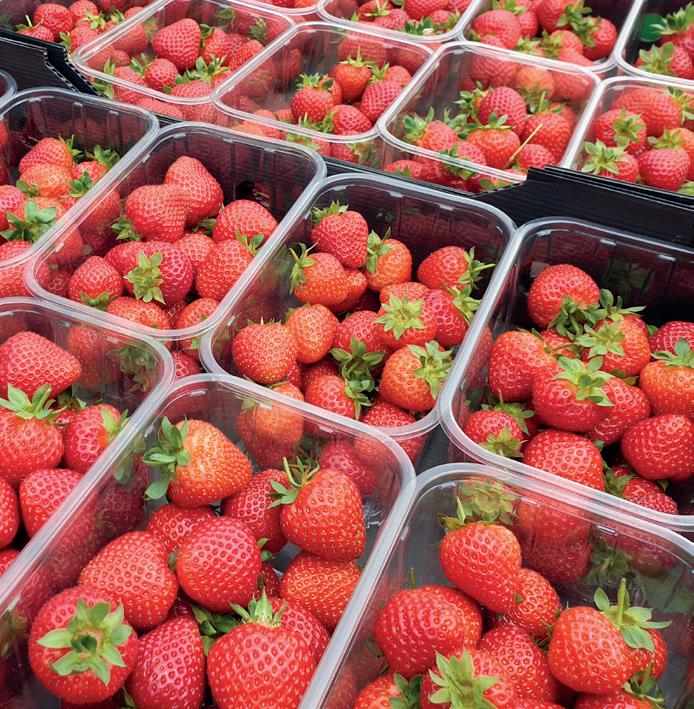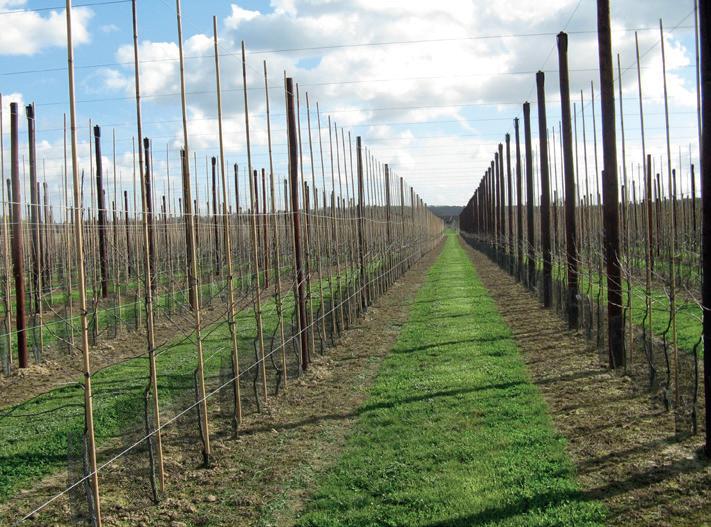
4 minute read
Novel approaches to insect pest control in soft fruit


Advertisement

Title: SF 174: Improving integrated pest management in soft fruit crops
Funder: AHDB
Partners: ADAS, Russell IPM, University of Greenwich (Natural Resources Institute), University of Keele
Term: April 2020 to March 2023
With the continuing loss of authorised products to control insect pests in soft fruit crops, AHDB has been funding a series of research projects to identify and develop novel approaches to control which do not rely on traditional chemical spray application. Despite the winding down of AHDB Horticultural operations in 2021, the funding for this project continued until its contractual end date of March 2023. It has focussed on finding controls for capsids, aphids and thrips, all pests that have been ranked as a high research priority by the industry.
The project
Both in this and previous AHDB funded research projects, work has developed a ‘push-pull’ approach to capsid control. A semiochemical ‘push’ using hexyl butyrate was deployed in the crop (Figure 1) in combination with a semiochemical ‘pull’ in green cross vane funnel traps (strawberry only) at regular intervals around the crop perimeter. This approach has significantly reduced numbers of capsids in both strawberry and raspberry in both this project and in previous projects. Further work has been ongoing with Russell IPM, who are commercialising the hexyl butyrate ‘push’ component. Work has also been done in this project to assess the efficacy of biological control of capsids using the predatory bug Orius.
Controlling aphids early in the season has become increasingly difficult as populations multiply relatively quickly at low temperatures. Many contact-acting biopesticides work less effectively at low temperatures and it can be difficult to hit aphids when they are hidden in the centre of plant crowns or in unfurled leaves. Hoverflies are effective natural enemies of aphids (Figure 2) with adult females laying lots of eggs in aphid colonies, but they tend to migrate into crops later in the season, once aphid populations have reached damaging thresholds. The purpose of this trial was to release hoverflies into the crop earlier in the season and to use volatiles to retain them in the crop.
Further work was done to understand how we can get more effective control of aphids using parasitoids. Working with scientists at the James Hutton Institute, research is ongoing to understand if parasitoids are overwintering in aphid colonies, to find out how much parasitoid releases help to boost existing levels of parasitism and identify any impact they are having on aphid numbers after their release.
A great deal of thrips research on strawberry has been done over the past decade and growers are generally successfully controlling western flower thrips (WFTFrankliniella occidentalis – Figure 3) with IPM techniques employing both Neoseiulus cucumeris and Orius predators to gain control. However, several other species that fly into strawberry crops during the growing season are being found and trapped in crops, some of which cause damage and lead to crop losses. Many of them are not breeding in the crop, so are not always being controlled by methods employed for WFT. Previous AHDB funded work by ADAS has regularly recorded rubus thrips (Thrips major), onion thrips (Thrips tabaci), rose thrips (Thrips fuscipennis) and flower thrips (Frankliniella intonsa) as being present and causing damage. Recent work in this project has been assessing the use of sticky traps along with commercial lures both to monitor and control these non-WFT species.
Results
Capsid control: As a result of this project, Russell IPM has developed a commercial product incorporating hexyl butyrate as a capsid repellent. It is delivered as a tablet which lasts for 3 months at 24°C and is spaced in the crop every 5 metres, either between bags/containers or alongside. For controlling European tarnished plant bug (Figure 4), in organic crops, it should be introduced to the crop in Spring and in conventional crops in June.

Growers have reported fewer European tarnished plant bug (Lygus rugulipennis) where Orius laevigatus has been introduced to control other pests. In laboratory experiments, significantly fewer Lygus nymphs emerged from eggs where Orius was present. However, in field trials in 2022, Orius did not significantly reduce either the numbers of L. rugulipennis or the damage caused by the pest, so it was concluded that Orius may be contributing to Lygus control, but not in any significant way and it should not be relied upon solely for control.


Aphid control: In several trials to assess the use of early hoverfly release with volatiles to retain them, initial attempts to establish hoverflies with one volatile was inconclusive, but subsequent trials using Magipal™ and other volatiles to attract naturally occurring hoverflies showed significantly more promise, although there were no significant differences between treatments. The volatiles were tested on a larger commercial scale trial in 2022 to attract naturally occurring hoverflies. Where substantial aphid colonies were present (Figure 5), higher numbers of hoverfly were attracted into the crop, but not where only low aphid colonies were present. This suggests that hoverflies should only be released when aphid numbers begin to build up. Further work needs to be done on which commercially available hoverfly species predate which aphids and the best timing for release.
Parasitoids were found to overwinter in the crop in aphid colonies and increased in number once aphids were available to parasitise. However, further parasitoid releases in spring did not significantly increase levels of parasitism and there was no impact on aphid numbers following their release in this one year study. Work is ongoing to identify the species that overwintered and whether parasitoid releases changed the species assemblage. It is important that growers know if there are parasitoids in the crop going into the winter, as this can inform the decision to release parasitoids or apply plant protection products the strawberry tabletop support systems. Initial work to identify which species are being caught have shown that WFT numbers are very low where growers have successfully controlled this species with IPM programmes. When the lures Lurem-TR (containing methyl isonicotinate) and Thripnok (containing a semiochemical) were used in combination with the traps, they didn’t significantly increase catches of non-WFT species. However, when ADAS scientists compared the positioning of blue sticky traps beneath the crop canopy with positioning them directly above, significantly more non-WFT thrips species were caught in traps above (Figure 6), and when Lurem-TR and Thripnok were added to traps above the crop, they further increased trap catches. In addition, more nondamaging species like cereal thrips were caught on traps hung below the canopy, which could lead growers and agronomists to misidentify thrips









